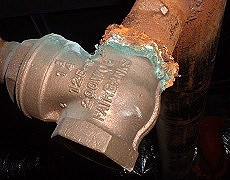Galvanic Corrosion
- Two electrochemically dissimilar metals must contact one another. They are dissimilar in the sense that they are far apart on the anodic index, which rates metals based on their electrode potentials. Metals that are more active (such as magnesium and zinc) will corrode in the presence of metals that are less active (such as gold and platinum).
- There must be an electrically conductive path between the two metals. Any non-metal, liquid substance that can conduct an electric current (such as saltwater or rainwater) can function as an electrolyte. Common examples are ordinary seawater, citric acid, and bases.
- An electrical path must exist to allow metal ions to move from the active metal to the less active metal. Typically, the metals merely touch one another.
- ACQ (alkaline copper quaternary) lumber includes copper, which can corrode when it comes in contact with common aluminum building nails. With this type of lumber, it's best to use G185 galvanized steel or stainless steel fasteners, as they will resist corrosion.
- Aluminum wiring can become compromised. In the presence of moisture, aluminum will undergo galvanic corrosion when it comes into contact with certain dissimilar metals.
- Piping commonly rusts and corrodes, especially at joints. The failure of pipe thread is commonly caused by corrosion where carbon steel pipe directly meets a brass valve, or where it transitions to copper pipe. Dielectric unions may be installed to separate these metals to resist damaging corrosion in pipe connections.
- The elements of an electric water heater often rust and fail. The copper sheathe and steel base, if they become wet, may corrode. Installing galvanized unions with plastic nipples on the top of the water heater can prevent corrosion.
- Electrically insulate the dissimilar metals. Plastic can be used to separate steel water pipes from copper-based fittings. A coat of grease can be used to insulate steel and aluminum parts.
- Shield the metal from ionic compounds. This is often accomplished by encasing the metal in epoxy or plastic, or painting it. Coating or protection should be applied to the more noble of the two metals, if it is impossible to coat both. Otherwise, greatly accelerated corrosion may occur at points of imperfection in the less noble (more active or anodic) metal.
- Choose metals that have similar potentials. Closely matched metals have less potential difference and, hence, less galvanic current. The best such solution is to build with only one type of metal.
- Electroplate the metals.
- Avoid threaded connections, as they are most severely weakened by galvanic corrosion.
Galvanic corrosion (also known as bimetallic corrosion or dissimilar-metal corrosion) is an electrochemical disintegration that occurs when dissimilar metals come in contact with each other while immersed in an electrolyte. Galvanic corrosion is of major concern anywhere moisture can reach metal building components. Corrosion as a broader category is defined as the disintegration of a material into its constituent parts, which may be caused by crevice corrosion, microbial corrosion, and high-temperature corrosion.
a broader category is defined as the disintegration of a material into its constituent parts, which may be caused by crevice corrosion, microbial corrosion, and high-temperature corrosion.
There are three conditions that must exist for galvanic corrosion to occur:
The Statue of Liberty is perhaps the most famous case of galvanic corrosion. Contact between the wrought-iron support and the outer copper skin amidst rainwater exposure has allowed the structure to gradually corrode. The famous icon's builder anticipated this problem and installed asbestos cloth soaked in shellac insulation in the 1880s. This worked for some time until it dried up and became porous, acting as a sponge that held saltwater close to the contact points between the two metals. An inspection in 1981 revealed severe galvanic corrosion of the iron supports, causing them to swell and push saddle rivets through the copper skin. This rapidly worsening situation was the main drive to restore the statue in 1986, when the iron was replaced with a variety of corrosion-resistant steel. The solution has held up, and native New Yorkers and visitors alike have been able to enjoy a landmark free from corrosion that will last long into the 21st century.
Examples in Houses
Galvanic Corrosion Can be Prevented in the Following Ways




